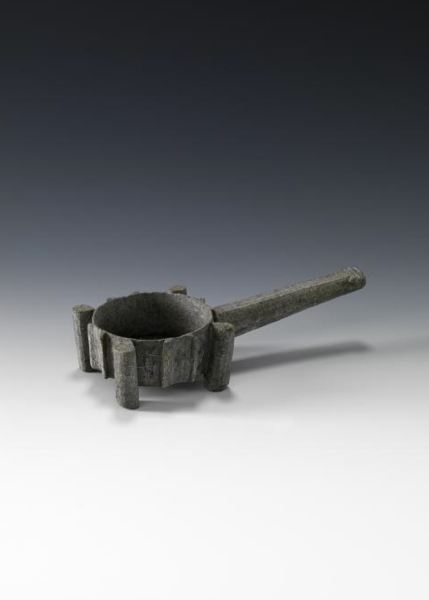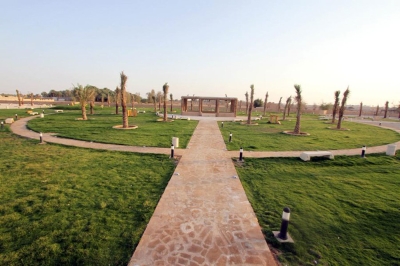
The Soapstone Censer is an ancient incense burner carved from soapstone, featuring a circular basin. It was discovered in the historic area of al-Rabadha, located about two hundred km east of al-Madinah al-Munawwarah, near the western Hejaz Mountains in the Kingdom of Saudi Arabia.
Description of the censer
The soapstone censer has four legs, each pair opposite one another, with each leg shaped like a triangle extending from the basin and reaching the ground. Additionally, four shapes are carved to extend from the basin, with each pair also facing one another. One of these shapes extends a long, faceted handle, which narrows as it moves away from the body of the censer. The handle features two horizontally engraved lines along its length, ending in a carved section. Geometric shapes, including semi-circles, dots, and vertical lines in black, are evenly distributed along the body and legs of the burner. Remnants of incense material and burn marks were found in the censer.
Measurements of the censer
Body diameter: 9.4 cm.
Height: 5.6 cm.
Handle length: 14.3 cm.
History of the censer
The soapstone censer dates back to between the eighth and ninth centuries. It was used for burning incense and is preserved at the Archaeology Department Museum at King Saud University in the capital, Riyadh. It is registered under number R–8–102, and was selected as part of a diverse collection of archaeological discoveries from Saudi Arabia for the Saudi Archaeological Masterpieces Through the Ages Exhibition, held at the Louvre Museum in the French capital, Paris, in 2010. The exhibition featured three hundred pieces made of various materials and spanning different periods, all originating from various regions of Saudi Arabia. These pieces are classified chronologically into three groups: from prehistoric times, from pre-Islamic times, and from Islamic periods.
The discovery of the censer is part of the results of the archaeological surveys and excavations conducted by the Antiquities and Museums Sector in Saudi Arabia over the past years. It is among the findings of Saudi archaeologists and scientific missions.
Significance of the censer
This censer, carved from soapstone, is an early example of the incense burners that Muslim artisans in the Arabian Peninsula excelled at carving and decorating. It is distinguished by its well-crafted design and high-quality carving. It was used for burning aromatic materials, such as incense, inside mosques, congregational prayer halls, and residential homes, in addition to its other uses in medical and therapeutic fields.
Related quizzes
Related articles

